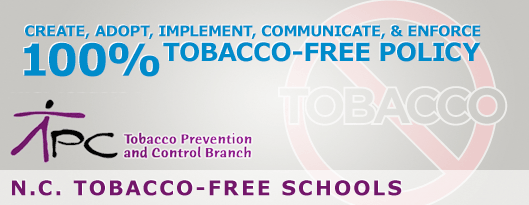Note: This site documents N.C.’s work on making public schools tobacco free, from 2000 until state law went into effect in 2008, and is provided as a resource for states and communities currently working to make their schools tobacco free. Factual information reflects research and data from 2000-2008.
Preparing for a School Board Presentation on Tobacco-Free Schools
Making a presentation to the school board is a critical step in securing or defending a tobacco-free policy. It is the board that is ultimately responsible for policy enactment and enforcement.
Here are some issues to consider in planning and conducting the presentation.
Prior to the school board presentation
Prior to the school board meeting, assess or re-assess the position of individual members of the school board on the tobacco-free school policy. If possible, do this in face-to-face meetings. How many
are in favor of the policy? What makes it important to them? Those who are in favor should be given additional supportive information that will allow them to effectively articulate the reasons for their
position. It is also important to find out which members are neutral. They may lack critical information on the issue that can move them to change their position. Finally, try to meet with those who do
not support the policy. Why are they against it? While you may not be able to change their position, you will be better able to anticipate and prepare for their questions and challenges during the presentation.
Assemble and distribute information packets (see below) before the meeting. Regardless of their position, all school board members should be well prepared with information on the issue before the presentation.
Addressing the School Board
Planning the Presentation
The board meeting should be well orchestrated. The content addressed in the presentation will depend on many factors: who is presenting; issues and concerns of the school board; community support for
enacting a 100% tobacco-free school policy and the amount of time available to present. Below are some ideas on topics to include in the presentation and who might provide this information. Base your
decision on what topics to select, and who will provide the information, on what you think will be most influential to the school board. Encourage speakers to adopt a collaborative, rather than an “us
against them” attitude, with the school board. After all, you are all on the same side in striving to do what’s best for the youth in the school district. Ask each speaker if they can pledge their support
and the support of their agency (if feasible) to work together with the school district in making this policy change a success.
- Information on the health effects of tobacco use.
The presenter should be a credible medical/health professional. The health director of the local health department or well-known or influential physician in the community would be ideal to have on your side. The information should address the effects of tobacco use, including e-cigarette use, on the healthy development of children, the effects of secondhand smoke and e-cigarette aerosol, the particular effects on children with asthma and similar conditions, the relationship of smoking to common childhood illnesses, such as ear infections and upper respiratory infections (common causes of school absence), the extremely addictive nature of nicotine for youth, and the impact it has on the developing brain, including cognitive functions and learning.
- Impact of school tobacco use on youth/Youth opinion of a tobacco-free school policy.
The presenter should be an articulate, well-spoken youth advocate who has been involved in the issue. A member of a student tobacco prevention organization would be ideal. A student with asthma or a history that includes quitting vaping would also be a good choice. The presentation should offer the youth perspective on school tobacco use, starting out with how are they affected by tobacco use, including e-cigarettes, on campus and their opinions on the issue. Does it bother them to see teachers using tobacco on campus? Do they believe this provides a poor role model for students? Does allowing tobacco use on campus contradict health messages they receive in the classroom on the dangers of tobacco use including vaping? Are they bothered by tobacco use at school sporting events? It is the school board’s responsibility to provide a safe and healthy learning environment free from exposure to known carcinogens, and one in which adults are role models for healthy behavior. Students may also want to share their concerns about tobacco use – particularly vaping – among their peers and how they think this policy will lead to a decrease in tobacco use among youth. Students may want to present signed petitions or summaries of student surveys to demonstrate support for the policy change.
- School administrator’s perspective
School staff can provide information on tobacco use prevalence within the school district, current tobacco and e-cigarette prevention efforts, and information on how this policy will support comprehensive school health efforts. They can also provide an overview of the benefits they anticipate with the passage of a 100% tobacco-free school policy. For instance, a 100% tobacco-free school policy:
- Provides positive role modeling by adult employees and visitors;
- Reduces children’s observation of tobacco use and takes a firm stand against it;
- Supports, rather than confounds, prevention messages delivered in the classroom
- Provides a safe environment for students by reducing exposure to environmental tobacco smoke and e-cigarette aerosol.
– all of which are directly related to environmental tobacco smoke.
- Protects children from a dangerous and addictive drug;
- Prepares students for the realities of a tobacco-free workplace;
- Reduces cost of cleaning and maintenance on grounds and athletic fields;
- Reduces the risk of fire due to smoking materials.


